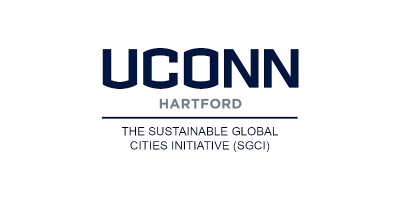
 An Online Resource from the
An Online Resource from the
Sustainable Global Cities Institute
.
Robert H. Wilson
Director
robert.h.wilson@uconn.edu
Ksenia Putintseva
SGCI Graduate Assistant
ksenia.putintseva@uconn.edu
Mission Statement
To invite researchers, students, practitioners, institutions,
and the general public to explore the challenges and responses
facing cities from COVID-19 around the globe.
About
The SGCI’s Cities and COVID online portal provides a curated resource guide to the extensive and growing research from universities, research centers, governmental and multilateral agencies, and trade organizations on the effect of the pandemic on cities and on strategies cities are contemplating for developing resilience to pandemics.
Given the relatively recent emergence of COVID-19, these resources often report on work in progress and reflections on the future and readers should therefore be aware of preliminary or “first cut” nature of this work. These resources should not be construed to be offering medical advice nor a reflection of views held by the SGCI or UConn, but are presented here as a reflection of the diversity of sources contributing to an ever-growing body of literature on the evolving coronavirus pandemic.
This resource guide, divided into three sections, will first review the historical record of pandemics, then examine the current COVID-19 crisis and its impact on cities worldwide, and conclude with a discussion of government responses and innovative solutions resulting from the COVID-19 pandemic. Visitors can navigate between these sections and the Cities and COVID home page by using the sidebar in the upper-left portion of each page.
Introduction
COVID-19 affects how we live, how we feel, and the way we think. Disparate population impacts of the COVID-19 pandemic can be observed around the world. Impacts on densely populated urban communities, already subject to social inequalities and disparities in health services, are further accentuated.
With an estimated 90 percent of reported COVID-19 cases, urban areas have become the pandemic’s epicenter as these indicators demonstrate:
- Travel to workplaces, retail/recreation, and transit stations reduced by 33%, 14%, and 26%, respectively, in the US metro cities.
- The US unemployment rate increased from 3.5% to 7.9% from September 2019 to September 2020 and declined to 6.2% in the first quarter of 2021.
- Estimates from the World Bank and UN entities suggest that local governments may, on average, lose 15 percent to 25 percent in revenues in 2021.
- Cities with a revenue base reliant on specialized sectors will be adversely affected; for example, declines in international tourism shrank sector earnings by as much as 80 percent in 2020, accompanied by the loss of 120 million jobs.
Even though signs of recovery are being observed in the US by the spring of 2021, the dramatic impacts of the pandemic still create opportunities for exploring the causes of disparities in incidence and efforts to enhance the resiliency of urban America to future pandemics. A range of research questions concerning the impact of COVID on cities arise, including:
- Which cities were most affected and what causes differences among cities?
- What causes disparities in impacts among subpopulations within a single city?
- Does urban population density affect infection rates?
- What effects are observed on urban mobility and commerce?
- What are the emergency responses to the crisis in cities?
Finally, given the experience derived from the current pandemic, and the effects of earlier pandemics, much of the world anticipates a new urban reality. Research questions involving long-term recovery for urban areas include:
- What factors affect recovery trajectories in cities?
- How will cities evolve following the short-term impacts of the COVID-19 crisis?
- How will the pandemic change the design of cities and the built environment in the future?
Last updated Spring 2021. Further updates will be announced on the SGCI home page.




